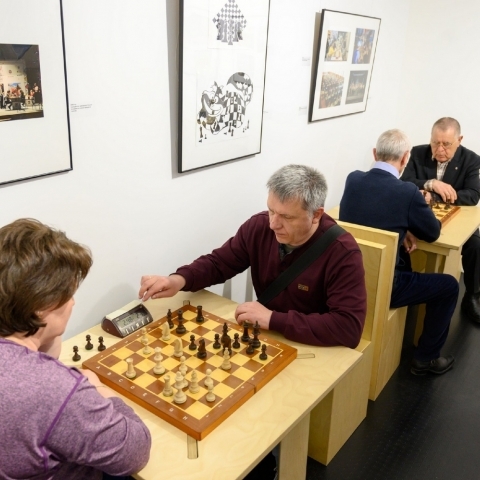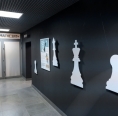-

Conquering Chess Heights
-
Address:
-
Partners:
The exhibition Conquering Chess Heights organized to coincide with the 20th anniversary the Vertikal chess club opened in the Magnezit museum on April 12.
The new exhibition welcomes visitors in the museum's lobby, presenting the first part of the exhibition: interesting facts from the history of chess. Some of the facts are relevant to Satka. For instance, one of the world's youngest grandmasters was Parimarjan Negi of India. He proved his status in Satka by meeting the last of the three criteria for international grandmasters in 2006. The second part of the exhibition is about the history of the chess movement in Satka District. This part is based on photographs from various chess events, awards won by Satkans, kids’ drawings and books about the intellectual game. Besides, visitors are welcome to sit down at chess tables and play a game with each other or take a quiz at the interactive kiosk and compete with a computer.
“The start of the chess movement in Satka was powerful. The Vertikal club opened on April 4, 2004 and in the fall later that year we held the Mikhail Botvinnik chess tournament. We’ve been most busy after that as well. Several major projects have been implemented over these 20 years such as Universal Chess Education and Chess for General Development – successful projects that are still active and not just in our district. The Cup of the Head of Satka District has taken place 30 times, with a total of over 4,000 chess players participating. Satka has become the host city for a lot of major events, such as the Chess Cup of the Governor of Chelyabinsk Region, the Satka Autumn (a stage of the Cup of Russia for women), the superfinal of Russia's championship for men and women, the superfinal of Chelyabinsk Region championship, and the school students games of 2005 where Chelyabinsk Region succeeded doubly by winning the individual all-round competition and the competition among regions. We have welcomed a number of famous grandmasters, such as Boris Spasskiy, Anatoly Karpov, Nonna Gaprindashvili as well as chess players that competed for the world’s chess crown, such as Yekaterina Lagno, Viktor Korchnoy, etc. And the outlook is at least as interesting. Around 200 school kids from Razdolinsk are learning to play chess here this year. Together with Yekaterinburg, we are planning to hold a summer school event where our pedagogues are going to tell their colleagues from Sverdlovsk Region how to give chess classes. But this year’s main events are scheduled for early September. Satka will become the platform for three all-Russian chess tournaments: the Magnezit Group Cup, the Satka Autumn and the Cup of the Governor of Chelyabinsk Region,” said Amir Gilyazov, Executive Director of the Vertikal chess club. “I’m grateful to the management of Magnezit Group, the Education Department of the district, veterans of the chess movement and employees of the Vertikal chess club for their support to the projects, and to specialists of the Magnezit Museum – for an interesting exhibition. One of the exhibits will be given to your fund as a sign of gratitude.”
A chess organization in Satka was first mentioned in 1937. The Satkinskiy Rabochiy newspaper published a short piece saying that a chess&checkers club had opened at the steelworks. The first tournaments were held in the same year. Today, the chess Satka is known way beyond the region and the country.
School kids of Satka take part in national and international competitions on a regular basis. The best chess players participate in the grandmaster school of Boris Spasskiy, the 10th world champion, which has become a traditional event held in Satka since 2003. It was Boris Spasskiy who called Satka the little chess miracle of the South Urals. In 2014-2016, Satka’s chess players won the 3rd place in the national and then international tournament Belaya Ladya (White Rook). In 2018, Satka won the competition for hosting the superfinal of the Russian Chess Championship for men and women. Satka’s chess projects are regular finalists in national competitions organized by the Chess Federation of Russia. For example, the project Chess for General Development at Primary School made the top 200 social projects out of 19,000 programs reviewed by the Strategic Initiatives Agency within the forum Powerful Ideas for the New Time in 2022.
“Today, we are proud of the personal victories or our children as much as we are of our chess projects. Satka has been in the top ten municipalities in the number of prize winners and absolute winners of the national contests for school kids in various academic subjects for 12 years. Chess is a component of this success. This game teaches how to live in peace and work as a team. I am grateful to Mr. Gilyazov for his amazing faith in chess. Chess education at schools became a point of growth for teachers as well as children. My congratulations on the start of the new chess year! I’m confident that it will be memorable and busy and, what is the most important, genuine, as everything you do. If this project were not genuine, people like world chess champions and the region’s Governor would never have faith in it,” Yelena Baranova, the Head of the Education Department of the district believes.
“I’ve been doing ski races, track and field, basketball and football all my life. But my first hobby was chess. When I was four, my dad bought me a chessboard, set out the pieces and taught me how they move. Dad played with pawns only. We played with him until I beat him three times. Then he added some pieces on his side. Eventually, I won the school championship when I was in the seventh grade. I didn’t win because I played well. It’s just that the level of chess education at schools was rather low at the time. The managers and teachers of the Vertikal chess club had done a tremendous job as proved by the success of their pupils in competitions of various levels,” added Nikolai Burmatov, Chair of the Satka District Deputies Assembly.
The exhibition is open until May 15. You can tour the exhibition on your own or buy a tour by dialing 9-46-84.
Source: Magnezitovets. Photo by: Vasily Maksimov
-
26.08 - 26.08
DIARY OF THE THIRD INDUSTRIAL BIENNALE
-
28.11 - 28.11
MY SATKA FESTIVAL WINS THE CONTEST OF CORPORATE VOLUNTEER PROJECTS
-
13.10 - 15.10
COOPERATION WITH VGIBL NAMED AFTER M.I. RUDOMINO




